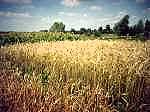|
"DREVLYANSKAYA" TETRAPLOID WINTER RYE

"Drevlyanskaya" kind of rye has been created in Institute of Health Promotion and Rebirth of People of Ukraine and Institute of Molecular Biology and Genetics of NAS of Ukraine using the method of "Belta" seeds treatment by modified exogenous nucleic acids of animal origin followed by plant selection on nitrogen depleted soils.
The way of the kind's use - the corn is used for food, the greenery and straw are used for forage.
The vegetation period comprises 307-312 days. The bush form during the bushing out is half stretched. The leaf color is dark green. The kind is of medium height. The stem length varies in the range 120-150 cm depending on growth conditions. The stem is massive, firm and destruction resistant. During trials in Zhitomir and Kiev region in 1989-1992 the resistance against lodging comprised 4-6 points, while for "Slavutich M-1" it was 3.3 points.
The kind is characterized by prismatic non-fragile ears, 10-12 cm in height, of gray-yellow color. The ear's thickness is medium (3-4 segments per 1 cm of ear).
The ear scales are 9-10 mm, narrow, double ribbed with barely visible crenation. The spines are 4.5-6 cm in length, prominent, of gray-yellow color. The corn is large, half long, carrying rare fuzzes on its edge, half opened, of gray-yellow color. The weight of 1000 seeds is 40-55 g.
The kind possesses high resistance against corn germination in the ear on the root, which provides high quality corn for sowing and food.
The "Drevlyanskaya" rye bushes well, its medium productive bushing is 4.0 stems, while that of "Slavutich M-1" kind is 3.4. This allows to decrease the rate of seeds sowing down to 3.5-4.0 millions of crops per hectare at favorable conditions, which increases the yield. The kind is winter resistant, resistant against root rot, snowy mould and mildew.
The disadvantage of the kind is plants' loss after long soaking (lasting more than a month) and red mildew affection.
The characteristics of the growing technology: the terms of tetraploid rye sowing coincide with wheat sowing terms in corresponding regions. The seed preparation includes screening of fine seeds fraction (25% are aneuploids). The necessary condition is spatial isolation (no less than 1000 m) from ordinary (diploid) rye, and mechanical mixing of seeds with diploid rye during storage, sowing and harvest is not allowed.
The mentioned features of the technology should provide preservation of the kind characteristics of the "Drevlyanskaya" rye as well as yield increase.
The author's competitive trial of the kind (carried out by the "New Crops" experimental base of NAS of Ukraine in Kiev region, Research Institution of Agriculture of Non-chernozem Zone of Ukraine, "Svitanok" collective farm of Korosten region of Zhitomir region and farms of Chutevsky region of Poltava area) on nitrogen depleted soils without any additional input of organic and nitric fertilizers showed that "Drevlyanskaya" kind of rye 14.3% exceeds "Slavutich M-1", the best kind of our selection, which undergoes the state trials at the moment, and 23.2% exceeds the diploid control of "Zhitomirskaya" rye. Since 1985 the competitive trials of the kind compared to the district kinds were carried out at farms of Zhitomir region, and in 1993-1995 the state trials of the kind were conducted.
The highest yield on ordinary soils of Kiev region comprised 55 centners per hectare. In the conditions of the state trials in 1994 in Chernivtsi and Hmelnitsk regions the yield of the kind reached 66-66.8 centners per hectare.
In 1997 the "Drevlyanskaya" kind of rye has been included into the State Register of the kinds of Ukraine and defined by the national standard for tetraploid kinds of rye.
The author's rights for the kind are protected by author's certificate No 406, 1997.
| 


